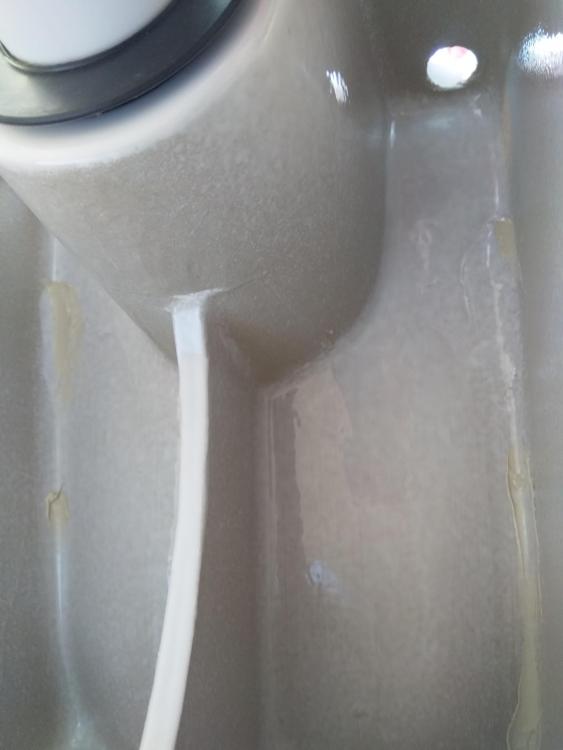Leaderboard
Popular Content
Showing content with the highest reputation on 09/03/19 in all areas
-
I don't see how choosing a different construction method could solve a housing shortage? Any housing shortage is the result of planning policy, and / or the way large house builders land bank land and only develop it when they believe they will be able to sell the houses quickly. It has little to do with the time it takes to build a house.3 points
-
Not hard to do some quick calcs to show how strong any fastenings need to be. The force from wind on a louvre that was in free air (worst case, as in your situation the louvres are going to partially shelter each other) is given by the projected area of the louvre (i.e. the face perpendicular to the wind) and the wind velocity. The equation is the standard drag equation: F = 0.5·ρ·CD·A·V² Where: F = force (in Newtons) ρ = air density in kg/m³ ( normally about 1.225 kq/m³) CD = drag coefficient, assume this is 1 to make the sums simpler A = projected area (largest face of the louvre) in m² V = maximum anticipated wind speed, in m/s So, for a 100mm wide louvre, 4m long, facing a wind speed of 100mph (~45/m/s), the force imposed by the wind would be 0.5·1.225·(0.1·4)·45² = ~496 N, or around 50.6 kgf. Taking an extreme case, where the louvre was fastened with a single 6mm diameter bolt in tension at top and bottom, and ignoring the possibility of bolt break out through the timber, then each bolt has a maximum tensile strength of about 10 kN, so two M6 316 stainless bolts in tension could withstand around 20 kN, or around 40 times the force exerted by a 100mph wind on a 4 metre long louvre. So, the short answer is that pretty much any fastening is going to be an absolutely massive overkill in terms of ultimate strength versus wind loading on these louvres, so don't worry an SE with it, just bolt the things in place. The more significant issue is really stiffness - if fixed so they don't flex much they will be absolutely rock solid in terms of fixing strength to resist wind loading.2 points
-
Someone needs to tell yer man that he needs to skim the topsoil off first - offload to the right - and then subsoil - offload to the left . That way you can re-fill the trench and replace the original topsoil. Not have to buy some in. Easy peasy. I dunno - amateurs.?2 points
-
1 point
-
When do you need them..?? Got a whole box of different sizes I can send you.1 point
-
https://www.ebay.co.uk/itm/Nitrile-7mm-ID-x-1-5mm-C-S-O-Ring-Choose-Quantity-7x1-5-New-Metric/293135773763?hash=item444040f043:m:mZAHIXQV1FNd_PbsrtdbwwA1 point
-
This thread is hanging on by the skin of it's teeth. PLEASE keep it on topic re self building or it WILL be gone.1 point
-
Agree with dave, building mass housing is not hard, you can choose any method and get a house up in about 14-16 weeks and habitable, it’s getting the councils to release the land and removing the profits from the developers that put a stop on things. Why are councils not making available serviced plots, ready to go with a small mark up on them.1 point
-
Phew - it wasnt anything we did - the toilet pan is defective! we took out the whole unit and set it up in the garden where we could look behoind while flushing the loo and we could then see where the water was coming from. inside the back are a couple of places with what looks like some sealant or putty. the drops are coming from those and wgen we looked very carefully, it was possible to see a crack that had been sealed over!! the B'@**ers had sent us a defective loo. and the OH has a video that shows the drops forming mainly from that top piece of sealant. I have contacted the company and all they have said is to send the photographs and they will be in touch. OH refuses to have another back to wall pan as it was such a faff to fit (being extra tall) so I have ordered a close coupled comfort toilet from the local builders merchants as well as a new basin. at least then, if we have any issues I can take it straight back. I guess I should have done that in the first place ..................1 point
-
You really need to factor in very large duct sizes to make this work. Warm air heating/cooling systems use ducts that are very much larger than MVHR ducting, typically they will be rectangular and typically be between about 200mm x 200mm up to maybe 200mm x 500mm. The large duct sizes are needed in order to be able to move the high air volume needed around without increasing the velocity to the point where it starts to get both noisy and cause high duct flow losses.1 point
-
What ya mention me for. Get a bunch of big nails and you can sleep easy.1 point
-
1 point
-
Nope - noise of the unit is incidental and the noise comes from either the air flow through the vent cowls (exhaust and supply) which is a function of air speed and vent gaps, or transmitted down the ducts. This can be sorted by using inline silencers.1 point
-
Have to leave mine running as it crashes the Bluetooth streaming for a couple of minutes of I turn it off ??1 point
-
It was what the British Empire, and buggery, were built on. Probably why I am social liberal and European.1 point
-
I can believe both of them. It annoys the hell out of me when I see delivery drivers doing it. And Taxi drivers. School run Mums and Dads. Ambulences Neighbour's friends Road Crews. Such an easy thing to do, but very few bother. I turn my engine off when I am at a red light.1 point
-
In our case it was because, more often than not, the tractor battery was so knackered that once you'd started it in the morning you didn't dare turn it off, because it wouldn't have been able to restart...1 point
-
Great list. There are a couple of ideas in there that we considered but didn't get around to (eg, warm water outside for car/dog). We wanted a secret room but it didn't really work with our plans. This is one huge benefit of having a home automation system run your lights. I've programmed the lights in the bathrooms, toilet, kids' bedrooms and the garage to turn off automatically after 2 hours (I haven't bothered with presence sensors, but if I had, I could significantly reduce this time). I also have a dedicated switch at the bottom of the stairs that turns off all upstairs lights, and the opposite downstairs. I can't tell you how satisfying it is not have to run around turning off lights. I don't know how much energy we actually save this way, but lights being left on is a pet peeve of mine.1 point
-
I'm new here, but have to say I'm enjoying how threads seem to take on a life of their own. Thanks for all the informed opinion on here, I appreciate it and it backs up my own view that we should proceed. Hooray! One last thing - I'm amused by the assumption by many on here that I'm a 'he'. Girls can build houses too!1 point
-
Another one for a motion movement sensor night light. I had one built in but my ensuite and dressing room are all one room with a dividing wall down about 2/3rds of it. My wonderful electrician put the sensor so it goes on as I go through the dressing area and if i'm longer than 2 minutes in the loo(which is rare but has been know) the light goes off so I have a back up battery one. I wouldn't have bothered with the built in if I had known, a few of the battery ones which are not expensive, would have been plenty. The batteries last about 6 months so no big deal there.1 point
-
MVHR does not deliver dry, heated, air normally. Unless there is some form of post-heating in the supply ducting then MVHR delivers air that is always cooler than the room air in cool weather. Definitely an extremely bad idea. Apart from kitchens being an extract room, with a specified extract rate in the regs, there is a very serious fire issue with supplying fresh air to a room (or garage) that may well be the initial seat of a fire.1 point
-
I doubt it makes much difference, but the most common MVHR terminals are the mushroom type, that draw air in from their edges mainly, with a fair bit of the flow being close to horizontal all the way around their periphery. Ideally there needs to be a clear area all around to allow the terminal to draw air more or less evenly around the peripheral opening, but given that the air flow needs to be throttled down a bit in almost all MVHR ducts, it probably doesn't make too much difference if flow is a bit restricted on one side.1 point
-
1 point
-
A few items I added recently: Ceiling sprinklers (fire) Outlet for christmas lights under eaves Hidden Safe, ideally in hallway so you can grab important stuff while running out (fire) Switched outlets for lighting in garden Outside faucet with hot water for washing the dog, filling swimming pool gas line to shed for that BBQ Extra Water supply line for irrigation Floor drain in bathrooms Floor drain in garage (washing the car, boots) Dumbwaiter Hidden Power Sockets in floor of larger rooms. Don't want to run power to center - trip hazard Light + Jamb switch in closets Roof Angle: 32 deg for optimal solar Mini secondary staircase - safety and also convenience Micro Shower in garage. If you ever want to convert to airbnb, but also to wash the kid, dog. Tiny hidden room - ok this is just for fun, but there could well be tiny spaces left over, and I wouldn't mind a 1.5x2 room with just a comfy seat, some bookshelves and a TV stapled to the door (obviously ethernet) Integrated Pest Control - lots of design choices are possible to stave off pests Pests Building Guide Led lights on some switches - we keep on forgetting the light in the garage, for example. Psychology knows why1 point
-
I'm afraid I've not found TP-Link kit reliable long term but perhaps its just me. Netgear has been ok as has DrayTek.1 point
-
Check the VoIP phone doesn’t have an in and an out port - some do and act as a switch on their own. If not, the cheapest TP-Link one from eBuyer will do you fine. VoIP can live on a 10/100 switch, no need for Gb Ethernet1 point
-
For most home users they are all much of a muchness. If I had to choose a basic brand for home use I'd go with either Netgear or TP-Link. Reasonably affordable, Plug and play, Simples. One thing that concerns me in the above - I'm assuming you are sending faxes and using the PC modem via the VoIP connection? or over a traditional phone line? I've had lots of problems with fax-over-voip in the past - have you tested this configuration?1 point
-
It may have a screwdriver slot in the hole in the grey cover, and turning that should adjust the set pressure. Both of the pressure reducing valves I've fitted had grey plastic covers that look a bit like that, and both have an adjustment screw on the top.1 point
-
I just had Kevin's Grandest Designs on in the background. I was very pleased to see that the Huf Haus couple from 2003 were still going strong and living in the house.1 point
-
Our issue I am sure is our very high mains water pressure so running any cold tap or the cistern filling is noisy. At the new house every cold tap apart from the kitchen comes from the pressure reduced feed and everything is very much quieter in operation.1 point
-
Yes, @JSHarris, having been literally been burnt with some cheap Chinese LED lights, I think I am leaning towards a big name (unless I can get a unit for under £1k). This particular outlet came back to confirm that the warranty is with them so for me is no good as I would want to know that they will be around during the warranty period. And I should probably be looking at having more faith in my heat loss calcs and size a bit more appropriately as 30% modulation seems standard on most brands so a 10kW unit may not make sense when heat loss indicates around 6000w.1 point
-
1 point
-
The general rule for all MVHR terminals, either extract or supply, is to make the path length that the air has to travel across the room as long as possible. This allows the best chance of there being no "short cut", where the ventilation air only crosses a part of the room, leaving corners less well ventilated. For example, if the fresh air to a room like a kitchen enters through a door (more likely under a door) then fit the extract terminal as far away from the door as possible, whilst making sure it's not tight in a corner (around 300mm to 400mm away from the walls is about right). Our kitchen door, where fresh air comes in, is near one corner, so I fitted the extract terminal diagonally opposite it, in the corner. The same goes for other rooms, so the living room, which has a door to the hall in one corner (which is the air extract point for this room) has the fresh air supply terminal in the opposite corner, so air has to flow diagonally across the whole room. Try not to have terminals in the centre of a room, as you have shown, unless it's a small room like a WC, as they may not work as well, in terms of ensuring even diffusion, as ones where the air path length is as long as it can be. For a shower, I fitted our extract right above it, as far from the door as possible, and that works pretty well.1 point










.jpg.c21f3ac78c9b7efd90cbdcb312744dc5.thumb.jpg.7adcad4c0e384f5ecd7d56b0618df6e5.jpg)


